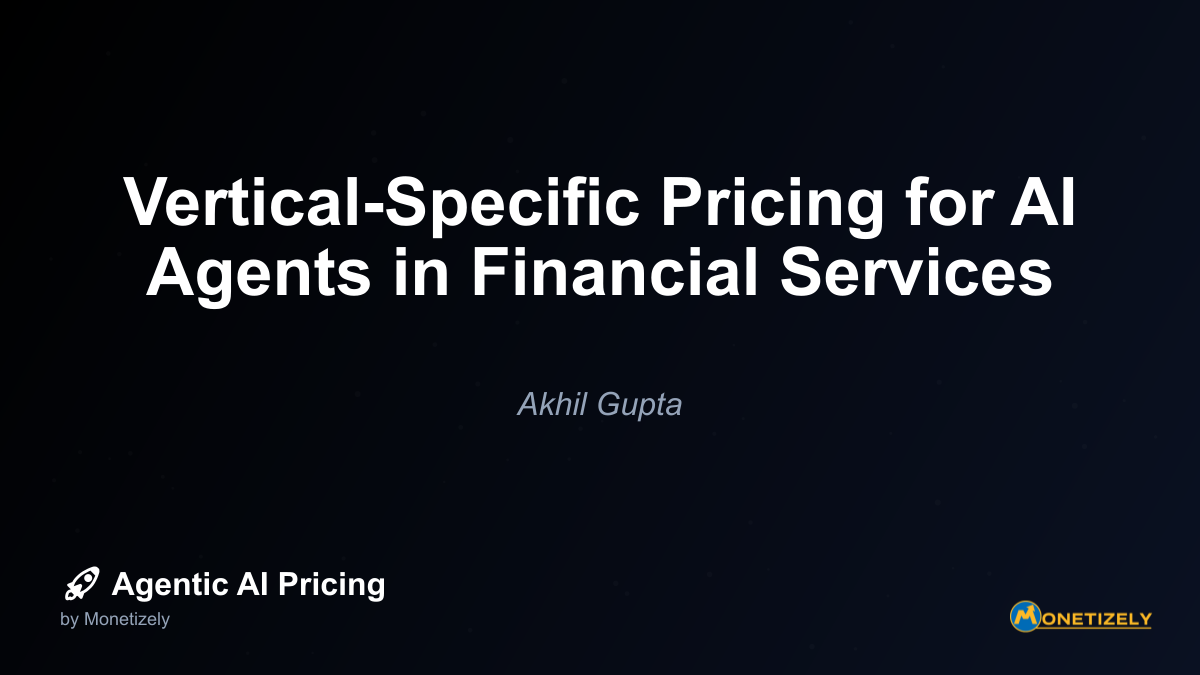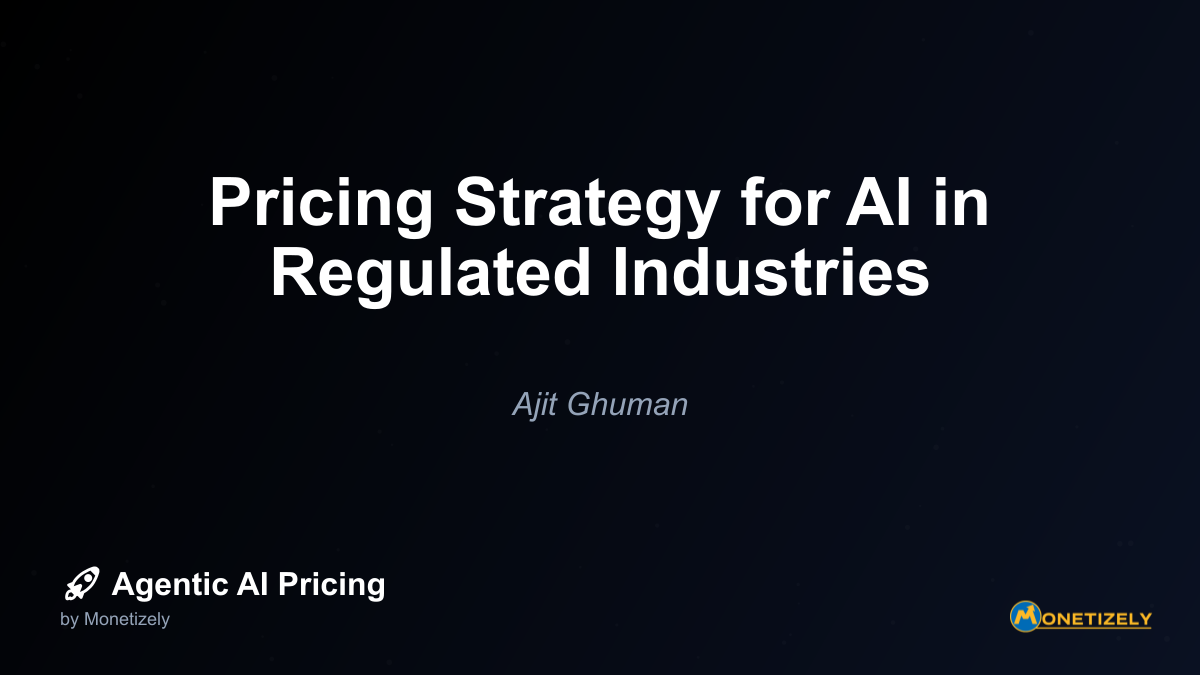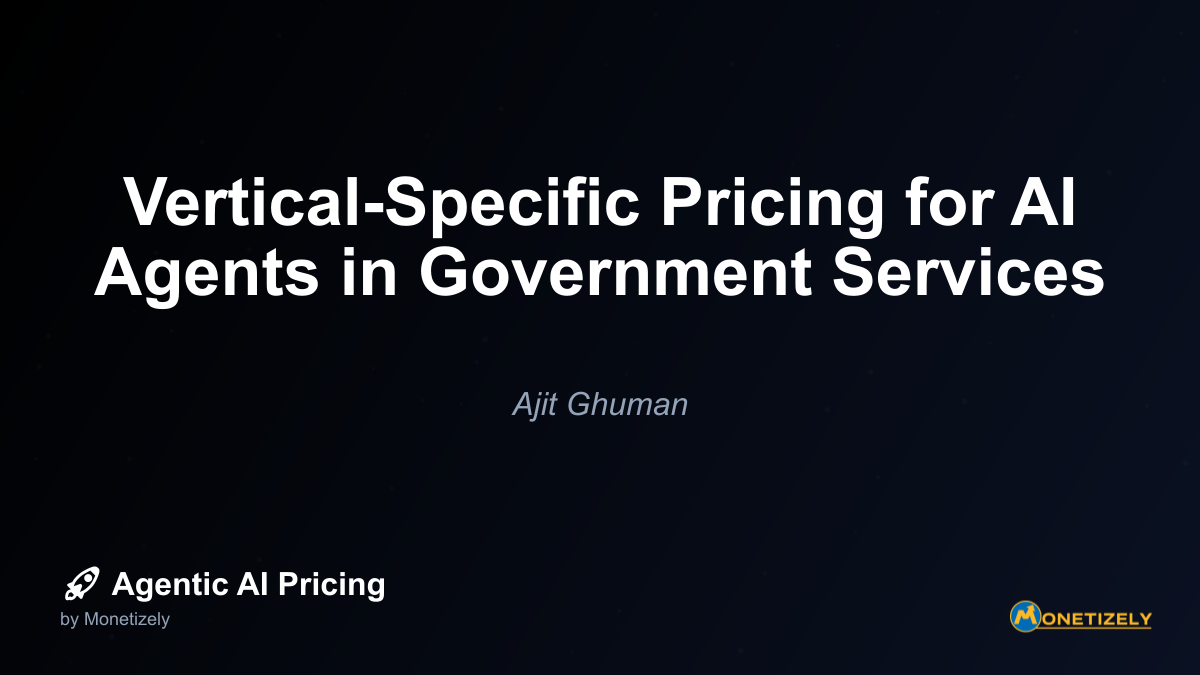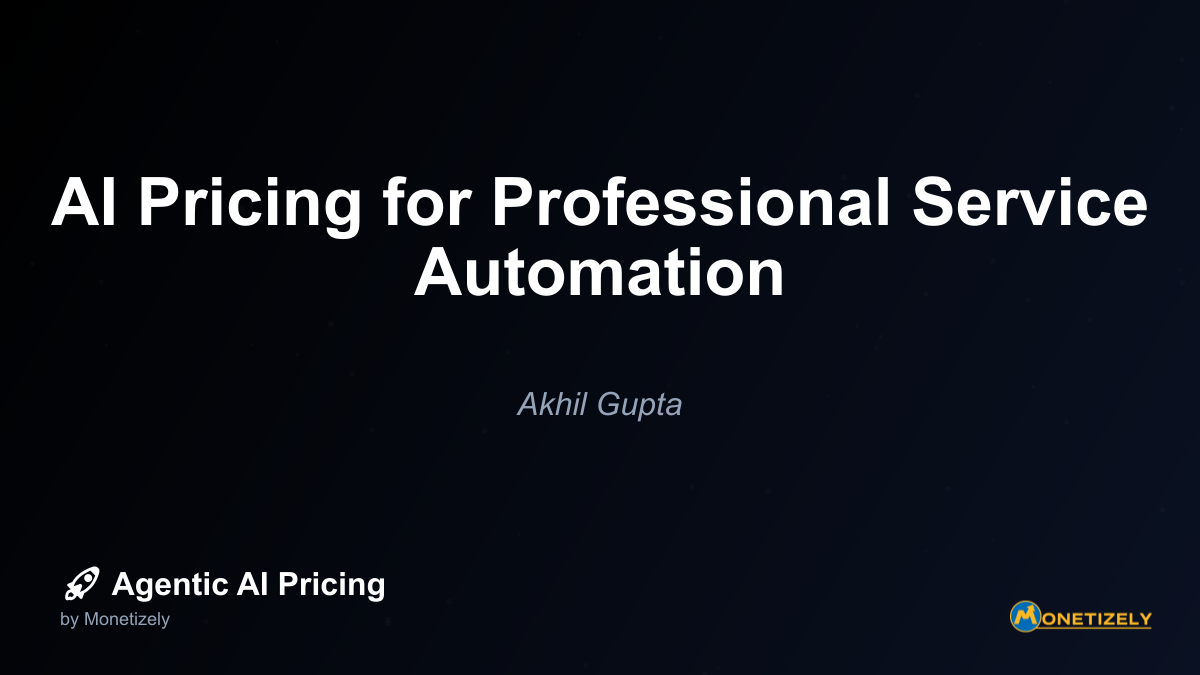· Akhil Gupta · Industry-Specific · 12 min read
Vertical-Specific Pricing for AI Agents in Legal Services
AI and SaaS Pricing Masterclass
Learn the art of strategic pricing directly from industry experts. Our comprehensive course provides frameworks and methodologies for optimizing your pricing strategy in the evolving AI landscape. Earn a professional certification that can be imported directly to your LinkedIn profile.
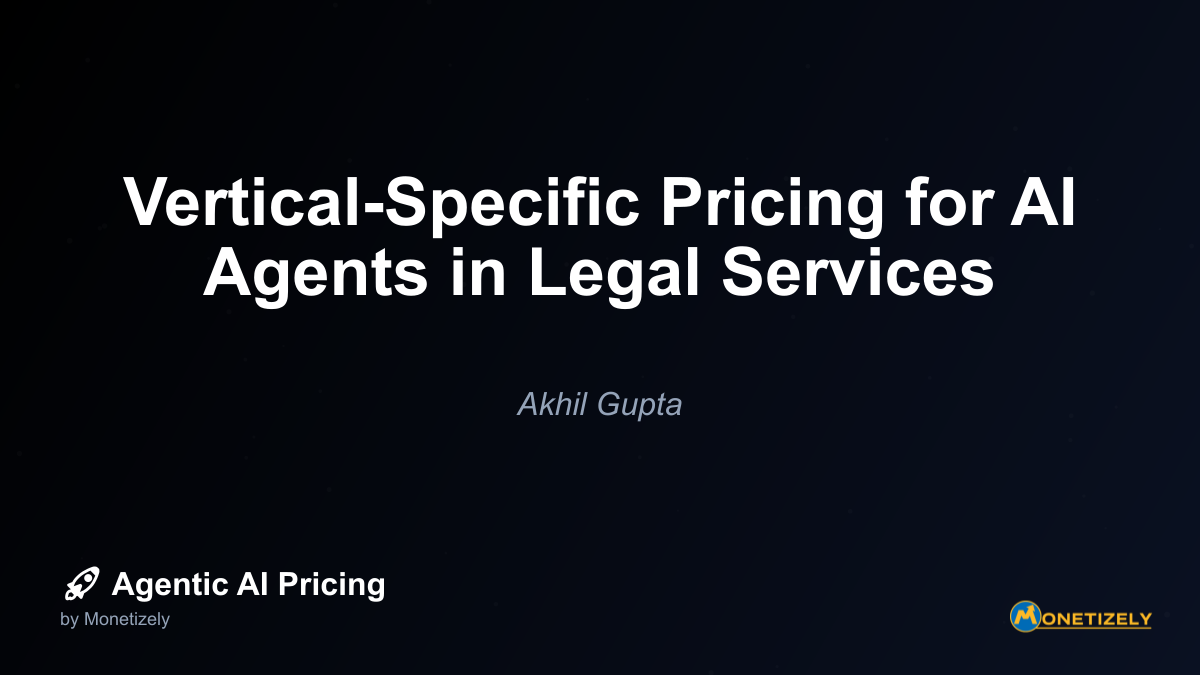
The legal industry stands at a pivotal crossroads as artificial intelligence transforms traditional service delivery models. For legal departments and law firms alike, determining appropriate pricing structures for AI-powered legal services presents both strategic opportunities and complex challenges. This comprehensive analysis explores the evolving landscape of vertical-specific pricing models for AI agents in legal services, with a particular focus on compliance, research, and document processing applications.
The Transformation of Legal Services Through AI
The integration of AI into legal services has fundamentally altered how legal work is performed, valued, and priced. Between 2023 and 2025, the market has witnessed a significant shift away from traditional billable hour models toward alternative fee arrangements (AFAs) that better reflect the efficiencies AI brings to legal workflows. According to recent market data, AFAs are expected to constitute over 70% of law firm revenue by 2025, up from just 20% in 2023, largely driven by AI adoption.
This transformation is particularly evident in three core areas:
- Legal Research: AI tools can analyze vast legal databases and deliver relevant insights in seconds, reducing research time by 60-70% compared to manual methods.
- Document Processing: Contract analysis and review that previously took days now requires only minutes with AI assistance.
- Compliance Monitoring: AI systems can continuously scan for regulatory changes and flag potential issues, transforming a traditionally labor-intensive process into an automated workflow.
The efficiency gains are substantial—AI-enabled associates can perform routine drafting tasks up to 70% faster than non-AI users. These improvements have created new expectations among clients, with legal procurement increasingly demanding “AI discounts” that reflect technology-driven efficiencies.
Current Pricing Models in Legal AI Services
The pricing landscape for AI legal services has evolved beyond traditional hourly billing to accommodate the unique value proposition these technologies offer. Several models have emerged as particularly effective:
1. Alternative Fee Arrangements (AFAs)
AFAs have become the dominant pricing structure for AI-augmented legal services, with several variations gaining traction:
- Fixed-Fee Pricing: Pre-determined fees for specific legal tasks or projects, regardless of time spent
- Capped Fees: Maximum fees with potential for reduction based on efficiency
- Phased Billing: Separate fixed fees for different project stages
- Success Fees: Payments tied to specific outcomes or milestones
These arrangements provide predictability for clients while allowing law firms to capture value from AI-driven efficiencies.
2. Subscription Models
Subscription-based pricing has gained significant momentum, particularly for ongoing legal support services:
- Tiered Service Plans: Law firms like K Bennett Law LLC offer monthly legal service subscriptions ranging from $500 to $2,000 per month, providing different levels of access to AI-augmented legal support.
- Enterprise Subscriptions: Larger organizations often negotiate enterprise-wide access to AI legal tools with tiered pricing based on usage volume or user seats.
- Service Bundles: Combinations of AI-powered services (e.g., compliance monitoring plus document review) offered at package rates.
The subscription approach provides predictable costs for clients and steady revenue streams for providers, while accommodating the continuous nature of many legal needs.
3. Value-Based Pricing
Perhaps the most sophisticated approach, value-based pricing determines fees based on the client’s perceived value and outcomes rather than inputs like time:
- Outcome-Based Fees: Pricing tied to specific client goals or successful results
- Risk-Sharing Arrangements: Providers share in both risk and reward based on outcomes
- Value Metrics Pricing: Fees calculated based on specific value metrics relevant to the client
This model requires deep understanding of client business objectives and collaborative scoping of success metrics, but can be particularly effective for high-value AI legal services.
4. Performance-Based Pricing
Particularly relevant for AI tools, performance-based pricing ties fees directly to the accuracy and effectiveness of the technology:
- Accuracy Guarantee Model: Pricing tied to specific performance metrics (e.g., 95% accuracy in contract clause identification)
- Service Level Agreements (SLAs): Pricing linked to guaranteed response times or processing speeds
- Credits for Underperformance: Vendors offer credits or refunds if AI performance falls short of guaranteed levels
This approach aligns payment with tangible value received and distributes risk appropriately, enhancing client trust in AI-powered solutions.
Vendor-Specific Pricing Approaches
Major providers in the legal AI space have developed distinctive pricing strategies that reflect their market positioning and technology capabilities:
Document Processing and Review Specialists
Kira Systems offers AI-powered contract review and due diligence tools with enterprise-tier subscription pricing, typically in the tens of thousands USD annually for mid-size firms. Their value proposition emphasizes significant reductions in manual review effort for M&A, compliance, and contract management.
Luminance provides AI-enabled document review and compliance tools through an enterprise sales model with custom pricing, often in the six-figure range annually for large corporate users. They differentiate by combining machine learning with pattern recognition to surface anomalies and risks in large document sets.
Legal Research Platforms
Casetext delivers AI-enhanced legal research through a subscription model with individual plans ranging from $99-$399/month and custom pricing for firms. Their CARA A.I. platform accelerates case law review with predictive relevance scoring.
LexisNexis offers comprehensive legal research and analytics through tiered subscriptions ranging from hundreds to thousands of dollars per user annually, based on access level and usage requirements.
ROSS Intelligence pioneered AI-driven legal research with natural language processing capabilities, though their pricing structure has traditionally been enterprise-focused with custom rates based on firm size and usage patterns.
Integrated Office Solutions
Microsoft Copilot (via Microsoft 365) provides document drafting and management capabilities at approximately $30/month per user as an add-on to existing subscriptions, with enterprise pricing available for volume licenses.
This diverse range of pricing approaches reflects the varied use cases, implementation complexities, and value propositions across the legal AI ecosystem.
The ROI Equation: Justifying AI Legal Service Investments
For decision-makers evaluating AI legal solutions, understanding the return on investment is crucial to determining appropriate pricing thresholds. Case studies and market data provide compelling evidence of the value these tools deliver:
Quantifiable Benefits
- Time Savings: AI tools reduce attorney work from hours to minutes for routine tasks, enabling reallocation of high-value legal talent.
- Cost Reduction: PNC Bank implemented Wolters Kluwer’s LegalVIEW BillAnalyser and achieved a 10% cost reduction alongside a 20% improvement in billing compliance.
- Accuracy Improvements: AI systems employing advanced Natural Language Processing achieve high scores on key performance indicators like F1-score, precision, and recall, reducing human error in document review.
- Risk Mitigation: Enhanced compliance monitoring identifies contradictory clauses or missing terms early, reducing potential liability.
These benefits must be weighed against implementation costs, including software licensing, integration expenses, and staff training. The calculation varies significantly based on organization size, complexity of legal needs, and existing technology infrastructure.
Small vs. Large Firm Approaches to AI Pricing
The approach to AI pricing varies substantially between small and large legal organizations:
Large Law Firms
Large firms typically invest strategically in advanced AI tools for predictive analytics, eDiscovery, and knowledge platforms. Their pricing strategies often include:
- Fixed-fee and value-priced services supported by AI-driven efficiencies
- Premium rates for high-value partner expertise combined with AI-augmented associate work
- Sophisticated client-facing dashboards demonstrating AI-driven value
- Custom enterprise contracts with major AI vendors
These firms leverage their scale to negotiate favorable AI licensing terms and amortize costs across numerous matters and clients.
Small and Mid-Size Firms
Smaller organizations face different constraints and opportunities:
- More likely to experiment with lower-cost or free AI tools for administrative tasks
- Often adopt subscription-based legal tech with predictable monthly costs
- May struggle with the economic and training barriers to large-scale AI adoption
- Increasingly use AI efficiency to compete with larger firms through fixed-fee models
For these firms, AI represents both a competitive necessity and a potential equalizer in a market historically dominated by scale advantages.
Implementation Challenges Affecting Pricing
Several implementation challenges directly impact pricing strategies for AI legal services:
1. Data Security and Privacy
The sensitive nature of legal information necessitates robust security measures:
- Encryption, access controls, and compliance with regulations like GDPR and HIPAA add complexity and cost
- Client concerns about data privacy may require additional safeguards and limit certain AI applications
- Vendors must demonstrate security certifications and compliance, affecting their cost structures
These requirements influence both vendor pricing and client willingness to pay for AI solutions.
2. Quality Control and Validation
AI outputs require ongoing validation and quality assurance:
- Human oversight, testing protocols, and correction mechanisms add to operational costs
- Firms must establish clear processes for reviewing AI-generated work
- The need for attorney verification influences the extent of potential cost savings
These factors affect how much of the efficiency gain can be passed to clients through pricing.
3. Change Management
Organizational adoption presents significant challenges:
- Training programs, stakeholder buy-in, and workflow redesign require investment
- Resistance to technology may slow implementation and delay ROI realization
- Cultural shifts toward technology acceptance take time and resources
Effective pricing must account for these transition costs while still delivering client value.
Regulatory Considerations for AI Legal Pricing
The regulatory environment significantly impacts AI legal service pricing in several ways:
1. Ethical Obligations
Legal ethics rules in many jurisdictions require:
- Reasonable fees for services rendered, even when AI-augmented
- Transparency about the use of technology in legal work
- Appropriate supervision of AI tools by qualified attorneys
These obligations can limit how much efficiency gain can be captured as profit versus passed to clients.
2. Evolving AI Governance
Emerging regulations focus on governing AI deployment and accountability:
- Intellectual property considerations for AI-generated content
- Liability frameworks for AI-generated outputs
- Transparency requirements for AI decision processes
Compliance with these evolving standards adds complexity and cost to AI legal solutions.
3. Client Confidentiality
Rules protecting client information create additional requirements:
- Secure data handling and storage protocols
- Limitations on certain AI applications or data uses
- Vendor contracts with appropriate confidentiality provisions
These requirements influence both implementation costs and ongoing operational expenses.
Future Trends in AI Legal Service Pricing (2025-2027)
Looking ahead, several key trends will shape AI pricing in legal services:
1. The “Golden Window” of Competitive Advantage
From 2025 to 2027, early AI adopters will enjoy a significant competitive advantage:
- Maintaining stable rates while significantly lowering operating costs
- Boosting profit margins through operational efficiency
- Potentially disrupting slower-moving firms that resist AI adoption
This period represents a critical strategic opportunity for forward-thinking legal organizations.
2. Increasing Client Expectations
Client demands will continue to evolve:
- “AI discounts” becoming standard features in RFPs by 2026
- Increased benchmarking against AI-augmented providers
- Growing expectation for self-service AI portals for routine legal queries
- Demand for transparent metrics demonstrating AI-driven value
These expectations will pressure firms to pass more efficiency gains to clients through pricing.
3. Predictive Pricing Evolution
AI-powered analytics will transform pricing approaches:
- Predictive analytics helping firms assess litigation risks and outcomes
- Dynamic pricing based on case complexity and forecasted timelines
- More sophisticated value metrics tied to business outcomes
- AI-driven client segmentation enabling tailored pricing strategies
These capabilities will enable more precise, data-driven pricing decisions.
Frameworks for Determining Optimal AI Legal Service Pricing
Organizations seeking to establish effective pricing for AI legal services can benefit from several structured frameworks:
1. The Value-Cost Matrix
This approach balances value delivered against cost structure:
- Value Assessment: Quantify time savings, risk reduction, and outcome improvements
- Cost Analysis: Calculate technology investment, ongoing maintenance, and human oversight requirements
- Client Segmentation: Identify different client groups with varying price sensitivity and value perception
- Competitive Positioning: Determine market positioning relative to alternative solutions
The optimal price point lies at the intersection of maximum client value and sustainable provider economics.
2. The Performance-Based Framework
This model ties pricing directly to AI performance metrics:
- Key Performance Indicators: Define specific, measurable metrics (accuracy, speed, compliance)
- Performance Tiers: Establish pricing levels tied to performance guarantees
- Risk Distribution: Allocate risk appropriately between provider and client
- Validation Mechanisms: Implement transparent processes to verify performance
This approach builds client trust while fairly compensating providers for superior results.
3. The Hybrid Value Model
Combining elements of multiple pricing approaches:
- Core Subscription: Base access to AI tools through subscription pricing
- Usage Components: Additional fees for volume or complexity beyond base levels
- Value Accelerators: Premium pricing for high-value applications or outcomes
- Risk-Sharing Elements: Success fees or performance guarantees for specific matters
This flexible framework accommodates diverse client needs and use cases.
Application-Specific Pricing Strategies
Different legal AI applications warrant tailored pricing approaches:
Compliance Applications
AI tools for regulatory compliance benefit from:
- Subscription Pricing: Regular monitoring requires continuous service
- Risk-Based Tiers: Higher pricing for high-risk, complex regulatory environments
- Outcome Guarantees: Performance warranties for compliance accuracy
- Volume Scaling: Pricing that accommodates growing regulatory complexity
Example: A multi-tiered compliance monitoring subscription with base coverage plus add-ons for specific regulatory domains.
Legal Research Applications
AI-powered research tools are effectively priced through:
- Usage-Based Models: Pay-per-search or volume-tiered pricing
- Performance Guarantees: Warranties for citation accuracy and relevance
- Outcome-Based Components: Premium pricing for high-value research outcomes
- Integration Pricing: Additional fees for integration with case management systems
Example: Base subscription with unlimited standard searches plus premium fees for specialized research assistance.
Document Processing Applications
Document-focused AI tools benefit from:
- Volume-Based Pricing: Fees based on document count or pages processed
- Complexity Tiers: Higher rates for complex document types or requirements
- Turnaround Guarantees: Premium pricing for accelerated processing
- Accuracy Warranties: Performance guarantees with remediation for errors
Example: Tiered pricing based on monthly document volume with surcharges for rush processing or specialized document types.
Communicating AI Value to Clients
Effective client communication is essential to support value-based pricing for AI legal services:
1. Quantifying Value
Articulate clear metrics that demonstrate tangible benefits:
- Time saved compared to traditional methods
- Cost reductions and efficiency improvements
- Accuracy enhancements and error reduction
- Risk mitigation and compliance improvements
These metrics should be specific, measurable, and relevant to client priorities.
2. Transparent AI Role
Clearly communicate how AI augments human expertise:
- Describe the division of labor between technology and attorneys
- Explain quality control and oversight mechanisms
- Highlight where human judgment remains essential
- Demonstrate the complementary relationship between AI and legal expertise
This transparency builds trust and justifies the value proposition.
3. Comparative Analysis
Show the advantages over traditional approaches:
- Side-by-side comparisons of traditional vs. AI-augmented workflows
- Case studies demonstrating successful implementations
- ROI calculations specific to the client’s situation
- Competitive benchmarking against alternative solutions
These comparisons help clients understand the value premium of AI-enhanced services.
Case Study: PNC Bank’s AI Implementation
PNC Bank’s implementation of Wolters Kluwer’s LegalVIEW BillAnalyser provides a compelling example of AI’s impact on legal services:
Challenge
PNC needed to improve vendor billing guideline compliance while reducing costs associated with manual review.
Solution
The bank implemented an AI solution that combined machine learning with legal expertise to automate the review process.
Results
The implementation delivered impressive outcomes:
- 10% cost reduction in legal expenses
- 20% improvement in billing compliance
- Exceeded cost-saving targets within the first year
- Enhanced data insights for strategic decision-making
- Improved vendor relationships through consistent enforcement
Pricing Approach
The solution utilized a performance-based pricing model with guaranteed savings thresholds, aligning vendor compensation with client outcomes.
This case demonstrates how AI can transform a traditionally manual, lawyer-intensive process into an efficient, data-driven workflow with substantial ROI.
Balancing Innovation and Tradition
For legal organizations, the transition to AI-augmented services requires careful balancing of innovation and tradition:
1. Hybrid Pricing Models
Most successful approaches combine elements of traditional and innovative pricing:
- Maintaining hourly billing for truly bespoke, high-judgment work
- Implementing fixed fees or subscriptions for AI-augmented routine tasks
- Developing value-based components for outcome-focused matters
- Creating transparency around where and how AI is utilized
This hybrid approach provides flexibility while capturing AI efficiencies.
2. Phased Implementation
A staged approach to AI adoption and pricing evolution:
- Begin with pilot projects using traditional pricing
- Transition to fixed fees as efficiency data becomes available
- Introduce value-based components as outcome metrics mature
- Develop fully integrated AI pricing as organizational capabilities evolve
This gradual progression manages change while building capabilities.
3. Client Co-Creation
Involving clients in pricing design enhances acceptance:
- Collaborative development of value metrics
- Joint pilot projects with shared risk and reward
- Transparent communication about AI implementation
- Feedback loops to refine pricing approaches
This partnership approach builds trust while aligning incentives.
Competitive Analysis of Major
Co-Founder & COO
Akhil is an Engineering leader with over 16+ years of experience in building, managing and scaling web-scale, high throughput enterprise applications and teams. He has worked with and led technology teams at FabAlley, BuildSupply and Healthians. He is a graduate from Delhi College of Engineering and UC Berkeley certified CTO.
Pricing Strategy Audit
Let our experts analyze your current pricing strategy and identify opportunities for improvement. Our data-driven assessment will help you unlock untapped revenue potential and optimize your AI pricing approach.

